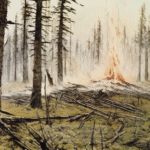What Lies Beneath the Surface of Loch Ness: Unraveling the Mystery of Nessie?
What Lies Beneath the Surface of Loch Ness: Unraveling the Mystery of Nessie?
The Loch Ness Monster, affectionately known as “Nessie,” is perhaps the most famous cryptid in the world. For decades, sightings and stories have captivated the imagination of millions, leading to a blend of folklore, science, and speculation. But what is it about this elusive creature that continues to spark interest and debate? This blog post will explore the mystery of Nessie, its historical context, core concepts, practical implications, and the ongoing research that fuels the quest for answers.
Historical Context: The Legend of Nessie
The lore surrounding Nessie dates back to the 6th century, with the first recorded sighting attributed to St. Columba, an Irish monk who reportedly encountered a “water beast” in the River Ness. Over the centuries, tales of a large creature dwelling in Loch Ness have evolved, with the first modern sighting occurring in 1933, when a couple claimed to have seen an enormous creature crossing the loch. This event sparked a media frenzy and led to a proliferation of sightings, photographs, and even the infamous “Surgeon’s Photograph” in 1934, which many believed to be definitive proof of Nessie’s existence.
Core Concepts: What Do We Know About Nessie?
Despite numerous investigations, the scientific community remains divided. Some researchers propose that Nessie could be a surviving Plesiosaur, a marine reptile from the age of dinosaurs, while others lean towards the idea that the creature might be a large eel or a misidentified animal. The following table summarizes the key theories surrounding Nessie’s identity:
| Theory | Description |
|---|---|
| Plesiosaur | A prehistoric marine reptile thought to inhabit the loch. |
| Large Eel | Some believe Nessie is a giant European eel, a species known to inhabit the loch. |
| Sturgeon | A large fish that could have been mistaken for a monster due to its size and behavior. |
| Log or Debris | Some sightings may simply be floating logs or debris, misinterpreted as a creature. |
Practical Implications: Evidence or Hoax?
The search for Nessie has led to various scientific efforts over the years. In 2003, a team of researchers conducted a comprehensive sonar study of Loch Ness, uncovering several unexplained underwater shapes but no definitive evidence of a large creature. In 2018, a genetic survey found traces of DNA from numerous species but did not identify any unknown organisms. This raises questions about the reliability of eyewitness accounts and the nature of the evidence presented over the years. The disparity between anecdotal reports and scientific evidence is a critical aspect of the ongoing discussion about Nessie’s existence.
Alternative Perspectives: Skepticism in Cryptozoology
While many enthusiasts remain hopeful about finding Nessie, skepticism runs deep within the scientific community. Critics argue that the lack of physical evidence, coupled with the nature of cryptid sightings, suggests that many reports are based on misperceptions or hoaxes. The phenomenon of pareidolia, where the mind perceives familiar patterns in random stimuli, may explain many supposed sightings. Additionally, a 2010 survey revealed that over 80% of Loch Ness residents do not believe in Nessie, highlighting a cultural divide between believers and skeptics.
Common Misconceptions: Debunking the Myths
Several myths and misconceptions surround the Loch Ness Monster that contribute to the ongoing fascination. One such myth is that Nessie has been confirmed by scientists; however, no scientific consensus exists to validate this claim. Another misconception is the belief that every sighting is credible; many have been proven to be hoaxes, such as the infamous “Surgeon’s Photograph,” which was later revealed to be a model. Understanding these misconceptions is crucial for a balanced view of the mystery.
Best Practices for Investigation: How to Approach Cryptozoology
For those interested in investigating the Loch Ness Monster, a structured approach is essential. Here are some best practices:
- Conduct thorough research: Familiarize yourself with historical accounts, current theories, and scientific findings.
- Engage with local experts: Speak with historians, locals, and scientists to gain diverse perspectives.
- Utilize technology: Employ sonar, cameras, and drones to document any unusual findings.
- Document sightings: Maintain a log of sightings, including date, time, location, and descriptions.
Future Developments: What Lies Ahead in the Search for Nessie?
The future of Nessie research may lie in advancements in technology. As environmental DNA (eDNA) analysis becomes more sophisticated, researchers can glean insights into the ecosystem of Loch Ness without disturbing the habitat. Additionally, increasing public interest in cryptozoology could lead to more funding for research and exploration. The ongoing quest for Nessie is not just about uncovering a creature; it’s about understanding our relationship with nature and the mysteries that lie within.
Conclusion: The Enduring Allure of Nessie
In conclusion, the mystery of Loch Ness and its legendary inhabitant, Nessie, continues to intrigue both believers and skeptics alike. From its historical roots to contemporary investigations, the tale of Nessie serves as a fascinating case study in the fields of cryptozoology and folklore. While definitive proof of Nessie’s existence remains elusive, the stories, the science, and the ongoing search provide a captivating glimpse into the unexplained mysteries of our world. Whether Nessie is a relic of the past, a misidentified creature, or a myth, its legacy endures, inviting further exploration and wonder.
Other Articles
Recent Posts
- What Happened to Flight MH370? The Conspiracy Theories That Still Haunt Us
- What Secrets Lurk Within the Walls of the Infamous Trans-Allegheny Lunatic Asylum?
- What Evidence Supports the Existence of Bigfoot in the Pacific Northwest?
- What Happened to the Indus Valley Civilization? Unraveling the Mysteries of Ancient Urban Life
- Can Telepathy Be Scientifically Proven Through Laboratory Evidence?







